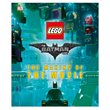What Went Wrong with The Lego Batman Movie--and Why It Matters
Sometimes, I don't like being right. When The Lego Batman Movie arrived in theaters last year, something about the trailers didn't look right to me. Obviously, it was intended to be a parody of Batman through the lens of a Lego-themed Batman world, but it felt like the movie was going to be something else so I avoided it ... until last weekend, when my curiosity got the best of me. It turned out that my initial instincts were right: For as goofy and absurd as it strives to be, The Lego Batman Movie simply isn't funny. However, what irked me the most was why it isn't funny, especially for a toy company that has otherwise mastered the art of genre parody. Read on ...
Plenty of comedy movies are released every year that aren't funny--that's just inevitable. However, I've enjoyed many of the Lego video games and TV shows, so I never expected something with the Lego name attached to it to be so dull. Making fun of the licensed property appears to be an essential part of the Lego licensing strategy. It's not enough for Lego to get the merchandising license for blockbuster franchises (Lord of the Rings, Harry Potter, Jurassic Park, etc.); Lego also finds a way to satirize these properties to increase their marketability. Sometimes, Lego can produce a license-based parody that also works as a compelling story that operates well within the narrative logic of the license (see my review of Lego Star Wars: The Freemaker Adventures). Lego's usage of parody has even extended to product lines that aren't based on a particular franchise. For example, the Lego City Undercover video game ably pokes fun at countless cop-themed TV series and movies, even though it is not specifically based on any of them.
On the other hand, there was The Lego Movie, which was released in 2014 and was written and directed by Phil Lord and Christopher Miller. This film took Lego's sensibility for satire and went completely "meta" with it, funneling Lego's style of play and its many product lines (both licensed and native Lego) into a gleefully jumbled story that totally makes sense from a child's perspective. This film was a big risk for something that only had a toy brand name behind it, but it paid off handsomely; then again, given Lord and Miller's hilarious animated version of the beloved children's book Cloudy with a Chance of Meatballs, their ability to take Lego's openness to absurdity to new levels should have been expected.
Everything is awesome: The Lego Movie.
So, with Lego's history of successfully mining humor to help sell its products, why did The Lego Batman Movie fail to be funny? I would say that the blame lies equally on Hollywood's interference with Lego's approach to comedy and Lego's continuing acquisition of licenses, to the possible point of overload.
Being the kind of nerd that I am, I have seen plenty of parodies of Batman. Many of them are hilarious: in particular, the '60s Batman TV series and the animated Batman: The Brave and the Bold knew how to milk the Caped Crusader's inherent absurdities to get laughs. Likewise, the Lego Batman video games demonstrate a deep understanding and love of Batman and DC universe, which are then used to create an ample supply of humor, sight gags, in-jokes, and goofy situations. Of the three Lego Batman games that have been made so far, the second and third are the most hilarious. In fact, with the second game reworked into an equally funny straight-to-video movie (Lego Batman: The Movie – DC Super Heroes Unite), the very idea behind The Lego Batman Movie feels redundant and unnecessary.
Building a better Batman in Lego Batman: The Movie -- DC Super Heroes Unite.
What sets the above examples of Batman parodies apart from The Lego Batman Movie is that they were created as Batman parodies. On the other hand, The Lego Batman Movie was created as a spin-off/semi-sequel to The Lego Movie first and a Batman parody second, and this order of priority shows why it lacks the inspired, impulsive humor of its counterparts. While the other parodies can focus on whatever aspects of Batman they want (the characters, the stories, the pop culture history, etc.), The Lego Batman Movie centers on the version of Batman that appeared in The Lego Movie. As such, every nod to the larger Batman franchise has to be adjusted to fit this specific version of Batman, thus becoming a parody of a parody. As such, the jokes don't always connect the way they should (no pun intended) or they wind up playing towards The Lego Movie version of Batman, a character that was originally conceived of as a supporting player/one-note joke and is not very funny on his own.
Further diluting the Batman parody angle is the involvement of other Lego licensed characters. In the DC universe, the Phantom Zone is where Superman imprisons some of his more dangerous villains; in The Lego Batman Movie, the Phantom Zone is changed to a warehouse of villain characters from franchises to which Lego has licensing rights. Thus, when the Phantom Zone is opened, Gotham City is overrun with characters that have nothing to do with Batman (King Kong, the Wicked Witch of the West, Lord Voldermort, etc.). This narrative ploy weakens the humor by pushing most of the Bat-centric cast into the background. Almost all of Batman's villains appear in The Lego Batman Movie but they are mostly reduced to scenery--a very odd choice for a movie that is ostensibly a Batman parody. For example, Billy Dee Williams provides the voice of Two-Face, which is a deliberate nod to the role that Williams was originally intended to play when Tim Burton was directing Batman movies years ago. Yet Two-Face barely says anything in The Lego Batman Movie and he's only seen briefly--what kind of in-joke is that?
I sort of understand why the makers of The Lego Batman Movie would want to blend other Lego licenses into this film. The previous Lego movie did the same thing (and to much greater effect) and I suppose the filmmakers saw this twist as a bigger threat for their Lego Batman to defeat, but the film doesn't get much comedic mileage out of it. In fact, making a movie based on the Lego Dimensions video game instead of a Lego Batman would have been a better choice to mine cross-license chaos for humor. (Fun trivia fact: Lego Batman is also a major character in the Lego Dimensions video game.) Then again, a Lego Dimensions movie could have also propped up the popularity of that license-based game line for a few more years, instead of folding in 2017.
Ultimately, companies like Lego need to be wary of licensing overloads. While they are very profitable and have built-in fan bases, blending licenses together to the point of becoming interchangeable components ultimately devalues them. Mixing up licenses may have worked for The Lego Movie, but they watered down the already bland genre parody in The Lego Batman Movie. I don't expect Lego to shy away from parody in the years to come as it amasses more licenses, but it should also be careful to remain focused on their individual strengths. I realize that my opinion of The Lego Batman Movie is not widely shared, but Lego does have a good thing going in how it has been handling its licenses so far. It would be a shame that in having toy licenses to almost everything, Lego would ultimately become nothing worth remembering.
Related Products:










Comments
Post a Comment